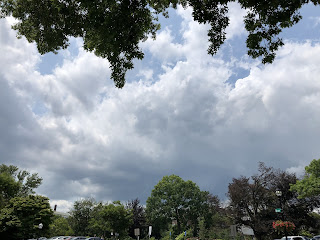On Tuesday, I rode to Connecticut. Otherwise, it's been a week of local rides, mainly because I've tried to get home before early afternoon, when the heat and humidity is usually worst.
Yesterday fit that pattern. It also fit another: I rode with a neighbor with whom I hadn't ridden before. The difference between Kevin, with whom I rode yesterday and Lillian, whom I mentioned in an earlier post, is that she is re-discovering cycling after 40 or so year, whereas Kevin is a lifelong cyclist who raced.
I didn't get a photo of him, and I'll say more about him (and Lillian) in later posts. I did, however, take some images of a ride that combined the old and the new for me.
The old: We pedaled along the East River waterfronts of Queens and Brooklyn to the Williamsburg Bridge, which we crossed onto Manhattan. We continued to the "bottom" of the island, where ferries dock.
We took one of the boats I'd never before ridden: the one to Governors Island. Being in a place where you're never more than a few hundred meters from the water is, of course, perfect on a hot day. If and when I go back, I'll pack a picnic lunch and circle the island a couple of times, as Kevin and I did.
I enjoyed riding with him, but I had the same sense of irony, tinged with a bit of guilt, I feel when I ride along Red Hook, Bush Terminal or other parts of the Brooklyn waterfront. Riding there is, of course, all about pleasure, and if I exert myself, it's an attempt to augment whatever training I might be doing. During my childhood, and before, some relatives of mine and kids I grew up with worked that waterfront--long, hard hours, most likely without much thought for the beauty of the water or waterfront--or the Manhattan skyline, so close but in another world.
Well, I had the privilege of other folks on the ferry: We were entering Governor's Island as civilians. My father didn't have that privilege: Whenever he went to the island, it was part of his duty as a Coast Guard reservist. He didn't enjoy it, in part because he was going there to perform repetitive tasks. But, more than anything, it was an inconvenience: When the island was a military installation, access was limited, as it is on other bases. What that meant was that only a couple of boats made the trip to and from the island every day, and if you missed the last one, you were stuck. On the other hand, today the boats make the crossing every 40 minutes starting at 10 am.
To be fair, my father might've appreciated some landmarks like the Castle or the officers' houses for the history behind them. But neither he nor anyone else went there to cycle, walk, picnic, camp or do anything for fun or recreation back in the day.
I plan to return, as I ride along the Brooklyn waterfront for fun. But the irony of my presence there, or on Governors Island, is not lost on me.














































